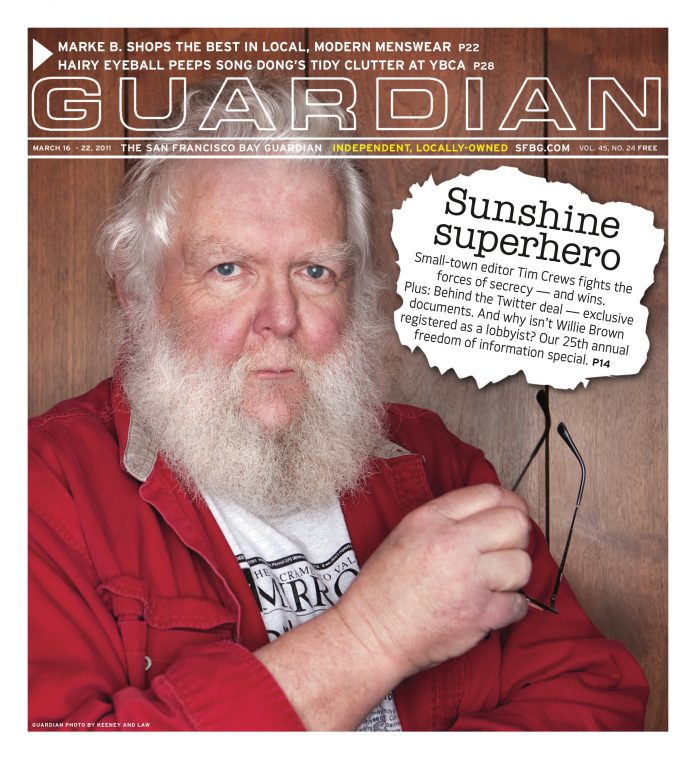arts@sfbg.com
MUSIC San Francisco’s Mi Ami was a trio when it released the spazz-punk albums Steal Watersports (2009) and Steal Your Face (2010) on Thrill Jockey. Then bassist Jacob Long announced that he was going to leave the group. After Long made that decision, Mi Ami played a few Bay Area shows at El Rio, Rickshaw Stop, and the Knockout. They were full-throttle performances — high in energy, as always. But they also revealed a ripping-at-the-seams that would soon be complete.
Mi Ami’s Daniel Martin-McCormick explains that he and remaining bandmate Damon Palermo believed that “the music we’d written as trio was specific to that dynamic.” Rather than recruit a new bassist, the remaining two Mi Ami members spent the past year experimenting with different arrangements to make the band work as a duo. “We tried different combinations with guitar and drum,” says Martin-McCormick. “Then we tried with me playing keyboards and Damon playing drums.” What they settled on — “Damon playing a drum machine and a sampler, and me doing stuff on top of it” — is even more surprising.
Dolphins, a 12-inch EP released on Thrill Jockey, is a first taste of the band’s new approach, which includes a vintage 707 drum machine, a sampler, keys, and of course Martin-McCormick’s trademark squall-vocals. In its new manifestation, Mi Ami ditches any resemblance to a traditional rock band. At the same time, the ideas behind the music are similar to those the band has always been traveling along. The influences are the same; then again, they’ve always been eclectic: post-punk to Italo-disco, dubstep to krautrock. The emphasis remains on being (and feeling) very live.
Mi Ami is bicoastal now that Martin-McCormick has relocated to New York City. But before the big move, the pair recorded Dolphins with Phil Manley. “We were puzzling over how to do the recording because the way we do it live is pretty bootleg,” Martin-McCormick says. “It’s pretty raw.” Manley suggested that Mi Ami just record the album live. So they did.
There are, of course, a few touch-ups. Even so, Dolphins is essentially a live performance, and one that encapsulates the quintessential give-and-take of the band’s music. “There’s a lot of interplay, and a lot of focus on creating, and jamming that out, and building on top of it,” Martin-McCormick said.
Mi Ami layers sounds, as on “Sunrise.” As the song emerges, there are undulating synth sounds and kraut beats. Next, steady keys slowly become awash with samples and the song transitions into jungle dub. Once the mood and atmosphere has evolved into a very different space, the track returns to the steady keys. Each song is given time to grow, build — even overflow — then fade away. And no two songs abide by the same rules. Each creates a unique evolution.
The EP’s opener, “Hard Up,” is chock-full of hypnotic beats and heavy bass, making it a perfect party starter. Its follow-up, “Dolphins,” begins where “Hard Up” leaves off — with dance-ready beats. As it unravels, however, it reveals something altogether different: ecstatic sounds turn into twisted grooves and anguished beats as Martin-McCormick’s apocalyptic cries create a juxtaposition of dolphins washing ashore while “Your wife in capris/ Drinking Hi-C and eating lima beans.” Through the sampler and keyboard, Martin-McCormick creates dying dolphin sounds, pushing his voice to an even higher register to sound dolphin-like. The track is a response, he explains, to “humanity’s assault on the environment.”
A final, poignant reinvention of the band is revealed on Dolphins‘ final song “Echo,” which has appeared in different forms and with slightly different titles (such as “Echoonoecho”) on two earlier releases. The sole through-line is Martin-McCormick’s vocal track. “We didn’t want to use Jacob Long’s bassline, but the vocal part could go over anything — it’s so repetitive,” he said.
Dolphins is proof that, although challenging, change isn’t always bad. In conjunction with the EP’s release, Palermo is traveling to New York to tour with Martin-McCormick as a duo for the first time. They’ll play a handful of shows in New York, moving on to the Midwest, and then to Europe. If we’re lucky, this journey will eventually include a return to the Bay Area.

